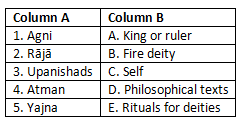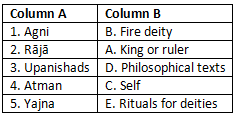Worksheet Solutions: India's Cultural Roots | Worksheets with Solutions for Class 6 PDF Download
| Table of contents |

|
| Multiple Choice Questions (MCQs) |

|
| Fill in the Blanks |

|
| True or False |

|
| Match the Following |

|
Multiple Choice Questions (MCQs)
Q1: Which of the following is the oldest of the four Vedas?
(a) Yajur Veda
(b) Atharva Veda
(c) Rig Veda
(d) Sama Veda
Ans: (c) Rig Veda
The Rig Veda is the oldest Veda, believed to have been composed around 1500 BCE. It is considered the foundational text of the Vedic tradition.
Q2: What does the word "Veda" mean?
(a) Truth
(b) Knowledge
(c) Power
(d) Wisdom
Ans: (b) Knowledge
The word "Veda" comes from the Sanskrit root "Vid," meaning "to know." It refers to a body of knowledge or wisdom, specifically spiritual and ritualistic knowledge.
Q3: Who are the composers of the Vedic hymns?
(a) Kings
(b) Rishis and Rishikas
(c) Common people
(d) Priests only
Ans: (b) Rishis and Rishikas
The Vedic hymns were composed by ancient sages or "rishis," who were inspired by divine revelations and crafted hymns for rituals and prayers.
Q4: Which deity is primarily associated with fire in Vedic rituals?
(a) Indra
(b) Agni
(c) Varuna
(d) Sarasvati
Ans: (b) Agni
Agni is the Vedic god of fire, central to many Vedic rituals, as fire was used in sacrificial offerings and ceremonies.
Q5: Which philosophical school emerged from the Vedas around the 1st millennium BCE?
(a) Jainism
(b) Buddhism
(c) Yoga
(d) Materialism
Ans: (c) Yoga
Yoga, as a spiritual discipline, was elaborated in the Upanishads, which are part of the later Vedic texts. It focuses on meditation and self-discipline to achieve spiritual enlightenment.
Fill in the Blanks
Q1: The four Vedas are Rig Veda, Yajur Veda, ________ Veda, and Atharva Veda.
Ans: Sāma
Q2: The Vedic hymns were passed down ________ for many generations.
Ans: orally
Q3: The concept of ________ refers to the divine essence present in every being.
Ans: Atman
Q4: The principle of ________ is crucial in Jain teachings, emphasizing non-violence.
Ans: Ahimsa
Q5: The Upanishads introduced the concept of ________, which is the cycle of being born again.
Ans: Rebirth
True or False
Q1: The Upanishads reject the idea of rebirth and karma.
Ans: False
Q2: Vedic chanting was recognized by UNESCO in 2008.
Ans: True
Q3: The early Vedic society was organized into small families only.
Ans: False
Q4: Jainism emphasizes the principle of non-possessiveness.
Ans: True
Q5: The Vedas were written down immediately after they were composed.
Ans: False
Match the Following
 Ans:
Ans:
















